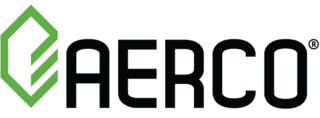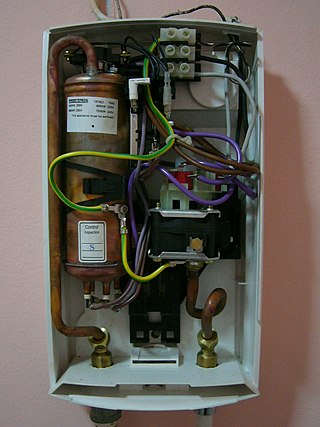
Heating, ventilation, and air conditioning (HVAC) is the use of various technologies to control the temperature, humidity, and purity of the air in an enclosed space. Its goal is to provide thermal comfort and acceptable indoor air quality. HVAC system design is a subdiscipline of mechanical engineering, based on the principles of thermodynamics, fluid mechanics, and heat transfer. "Refrigeration" is sometimes added to the field's abbreviation as HVAC&R or HVACR, or "ventilation" is dropped, as in HACR.

A heat pump is a device that uses work to transfer heat from a cool space to a warm space by transferring thermal energy using a refrigeration cycle, cooling the cool space and warming the warm space. In cold weather, a heat pump can move heat from the cool outdoors to warm a house; the pump may also be designed to move heat from the house to the warmer outdoors in warm weather. As they transfer heat rather than generating heat, they are more energy-efficient than other ways of heating or cooling a home.

A boiler is a closed vessel in which fluid is heated. The fluid does not necessarily boil. The heated or vaporized fluid exits the boiler for use in various processes or heating applications, including water heating, central heating, boiler-based power generation, cooking, and sanitation.

A furnace, referred to as a heater or boiler in British English, is an appliance used to generate heat for all or part of a building. Furnaces are mostly used as a major component of a central heating system. Furnaces are permanently installed to provide heat to an interior space through intermediary fluid movement, which may be air, steam, or hot water. Heating appliances that use steam or hot water as the fluid are normally referred to as a residential steam boilers or residential hot water boilers. The most common fuel source for modern furnaces in North America and much of Europe is natural gas; other common fuel sources include LPG, fuel oil, wood and in rare cases coal. In some areas electrical resistance heating is used, especially where the cost of electricity is low or the primary purpose is for air conditioning. Modern high-efficiency furnaces can be up to 98% efficient and operate without a chimney, with a typical gas furnace being about 80% efficient. Waste gas and heat are mechanically ventilated through either metal flue pipes or polyvinyl chloride (PVC) pipes that can be vented through the side or roof of the structure. Fuel efficiency in a gas furnace is measured in AFUE.

Water heating is a heat transfer process that uses an energy source to heat water above its initial temperature. Typical domestic uses of hot water include cooking, cleaning, bathing, and space heating. In industry, hot water and water heated to steam have many uses.

A central heating system provides warmth to a number of spaces within a building from one main source of heat. It is a component of heating, ventilation, and air conditioning systems, which can both cool and warm interior spaces.

A storage heater or heat bank (Australia) is an electrical heater which stores thermal energy during the evening, or at night when electricity is available at lower cost, and releases the heat during the day as required. Alternatively, solar storage heaters are designed to store solar energy as heat, to be released during the night or other periods where it is required, often making it more cost effective than selling surplus electricity to the grid and buying it back at night.

An absorption refrigerator is a refrigerator that uses a heat source to provide the energy needed to drive the cooling process. Solar energy, burning a fossil fuel, waste heat from factories, and district heating systems are examples of convenient heat sources that can be used. An absorption refrigerator uses two coolants: the first coolant performs evaporative cooling and then is absorbed into the second coolant; heat is needed to reset the two coolants to their initial states. Absorption refrigerators are commonly used in recreational vehicles (RVs), campers, and caravans because the heat required to power them can be provided by a propane fuel burner, by a low-voltage DC electric heater or by a mains-powered electric heater. Absorption refrigerators can also be used to air-condition buildings using the waste heat from a gas turbine or water heater in the building. Using waste heat from a gas turbine makes the turbine very efficient because it first produces electricity, then hot water, and finally, air-conditioning—trigeneration.
Condensing boilers are water heaters typically used for heating systems that are fueled by gas or oil. When operated in the correct circumstances, a heating system can achieve high efficiency by condensing water vapour found in the exhaust gases in a heat exchanger to preheat the circulating water. This recovers the latent heat of vaporisation, which would otherwise have been wasted. The condensate is sent to a drain. In many countries, the use of condensing boilers is compulsory or encouraged with financial incentives.

Underfloor heating and cooling is a form of central heating and cooling that achieves indoor climate control for thermal comfort using hydronic or electrical heating elements embedded in a floor. Heating is achieved by conduction, radiation and convection. Use of underfloor heating dates back to the Neoglacial and Neolithic periods.

An air source heat pump (ASHP) is a heat pump that can absorb heat from air outside a building and release it inside; it uses the same vapor-compression refrigeration process and much the same equipment as an air conditioner, but in the opposite direction. ASHPs are the most common type of heat pump and, usually being smaller, tend to be used to heat individual houses or flats rather than blocks, districts or industrial processes.
Stiebel Eltron is a company based in Holzminden, Germany, that manufactures central heating products such as heat pumps. The UK office was set up on the Wirral Peninsula in 2008. The company dates back to 1924 in Berlin, when Dr. Theodor Stiebel founded Stiebel Eltron. Today it is a green energy low carbon specialist manufacturing ground, air and water source heat pumps. It further produces ventilation and air conditioning and systems technologies. It has a worldwide turnover of €700 million and employs 4000 staff.

Radiators and convectors are heat exchangers designed to transfer thermal energy from one medium to another for the purpose of space heating.

Worcester Bosch is a United Kingdom based heating and hot water products manufacturer.
De Dietrich Remeha is one of Europe's biggest manufacturers and distributors of domestic and commercial water and space heating systems. Headquartered in Apeldoorn in the Netherlands, it was founded in July 2004 after a merger between the Dutch firm Remeha, and the French firm De Dietrich Thermique. In July 2009, the heavily laden with debt British Baxi group agreed to merge with De Dietrich Remeha, creating the BDR Thermea Group.

The Viessmann Group is a German manufacturer of heating and refrigeration systems headquartered in Allendorf (Eder), Germany. With 22 production companies in 12 countries, distribution companies and representative offices in 74 countries and 120 sales offices throughout the world, Viessmann is international in its orientation. More than 54 percent of turnover is generated abroad. Since January 2022, the company is led by Martin Vießmann, Maximilian Viessmann (Group-CEO) and Ulrich Hüllmann (CFO). In April 2023, Viessmann announced that it would sell its heat pump division to its US competitor Carrier Global for €12 billion. The transaction was completed on January 2024, Max Viessmann joins the Board of Carrier Global

AERCO International, Inc. is a manufacturer and supplier of commercial condensing boilers, high efficiency water heating equipment and energy recovery systems in the HVAC/plumbing industry across a variety of markets including education, lodging, government, office buildings, healthcare, industrial and multifamily housing. In 1949, AERCO introduced the industry's first semi-instantaneous, tankless steam-to-water water heater. In 1988, AERCO introduced the first condensing and fully modulating boiler and water heater to the commercial market. The company develops rapid water heating products and a product line that achieves 99% efficiency.

Rheem Manufacturing Company is an American privately held manufacturer that produces residential and commercial water heaters and boilers, as well as heating, ventilating and air conditioning (HVAC) equipment. The company also produces and sells products under the Ruud brand name. It is an independent subsidiary of Paloma Industries.What became Rheem started in 1925 as a supplier of packaging to the petroleum industry, and is currently headquartered in Atlanta, Georgia in the United States. The company is one of the largest manufacturers of both water heating and HVAC equipment in the United States, and also produces and markets products in Argentina, Armenia, Australia, Bahrain, China, Chile, Brazil, Canada, Iraq, Kuwait, Mexico, New Zealand, Perú, Oman, Qatar, Saudi Arabia, Singapore, UAE, and Ukraine.

Tankless water heaters — also called instantaneous, continuous flow, inline, flash, on-demand, or instant-on water heaters — are water heaters that instantly heat water as it flows through the device, and do not retain any water internally except for what is in the heat exchanger coil unless the unit is equipped with an internal buffer tank. Copper heat exchangers are preferred in these units because of their high thermal conductivity and ease of fabrication. However, copper heat exchangers are more susceptible to scale buildup than stainless steel heat exchangers.

Ariston Holding NV is an Italian corporation that produces heating systems and related products, marketed mainly under the Ariston, Chaffoteaux, Elco, Racold, Régent, Atag, NTI, HTP, Cuenod, Ecoflam and Thermowatt brands.
















